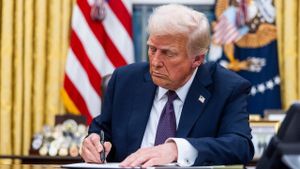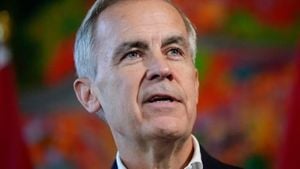The Canadian dollar, often referred to as the loonie, has found reprieve as it rallied significantly following the news of U.S. President Donald Trump’s trade policies. On Monday, as new reports indicated Trump would not impose immediate tariffs on Canadian imports, the loonie rose to its highest value against the U.S. dollar since mid-December, trading 1.1% higher at 1.4325 per U.S. dollar, or 69.81 U.S. cents.
Early speculation had been rife as financial markets anticipated potential tariffs of as much as 25% on goods imported from Canada and Mexico. But Trump's first-day executive order shifted the focus away from tariff implementation, marking what some market analysts interpreted as a momentary respite from looming economic threats.
According to The Wall Street Journal, Trump's directive has tasked federal agencies with evaluating existing U.S. trade relationships with Canada, Mexico, and China, but it falls short of promising swift action on the tariff threats.
"Financial markets are staging an across-the-board relief rally," commented Karl Schamotta, chief market strategist at Corpay. He noted the confirmation of no immediate tariffs boosted both investor sentiment and market performance, as most major currencies rose roughly one percent against the beleaguered U.S. dollar.
This unexpected surge provoked reactions throughout the Canadian economy, particularly among firms associated with energy production. Analysts highlighted the improved trading environment as significant, especially since Canadian energy stocks had been lagging behind U.S. peers.
"The Canadian energy stocks are responding positively to the news,” Schamotta explained. “Despite falling crude oil and natural gas prices, the overall relief surrounding tariff threats is breathing new life back to Canadian equities.”
Canada's Business Outlook Survey, released concurrently with these developments, revealed prevailing optimism among firms anticipating rising levels of activity and consumer demand. Although overall sentiment remains cautious, businesses expect selling prices to stabilize, which could signal potential recovery.
"Canadian firms see improved demand and sales in the coming year but express concerns about potential damage from promised U.S. policies," said Royce Mendes, head of macro strategy at Desjardins.
Trump's inaugural speech emphasized his administration's commitment to taxing foreign countries, but he did not mention Canada outright, reflecting less certainty on potential protections its imports might face.
Nonetheless, the underlying anxiety about possible tariff escalations remains. Derek Holt, vice-president at the Bank of Nova Scotia, noted, "We are always one Trump tweet away from much farther CAD weakness," highlighting the precarious nature of market sentiment moving forward.
Despite the initial lift, market analysts warn against excessive enthusiasm. "The loonie is merely enjoying a temporary reprieve from previous tariffs threatened—it certainly hasn't escaped the shadow of CETA negotiations or broader trade relations under the new administration," Holt added, indicating the volatile, uncertain path forward.
Such trade uncertainties can influence the broader economic environment, keeping both consumers and businesses on edge as they navigate changing expectations. The long-term outlook, especially concerning consumer behavior and investment readiness, remains hazy.
A sustained positive influence on the Canadian dollar could hinge on favorable economic reports and interventions from the Bank of Canada, which may decide to adjust interest rates based on prevailing financial conditions.
Recent estimates suggest the Bank of Canada may lower its benchmark interest rate by as much as 25 basis points, emphasizing its role as another catalyst for CAD movements.
For investors and market analysts alike, the immediate future calls for caution. Awaiting Trump’s definitive trade strategies along with speculations on repercussions from foreign relations will likely keep the markets reacting sensitively to all developments.
Despite the bounce back from tariff-induced fears, the volatility predicted by analysts augurs caution. "The loonie looks set for rollercoaster weeks to come as risks remain skewed to the downside, haunting from unexpected tariff strikes or economic decisions continuing from the Trump administration," warned analysts from Monex Europe.
With traders cautiously optimistic, the next few weeks will be pivotal for assessing the stability of the loonie and its enduring relationship with the U.S. dollar under Trump’s administration.



